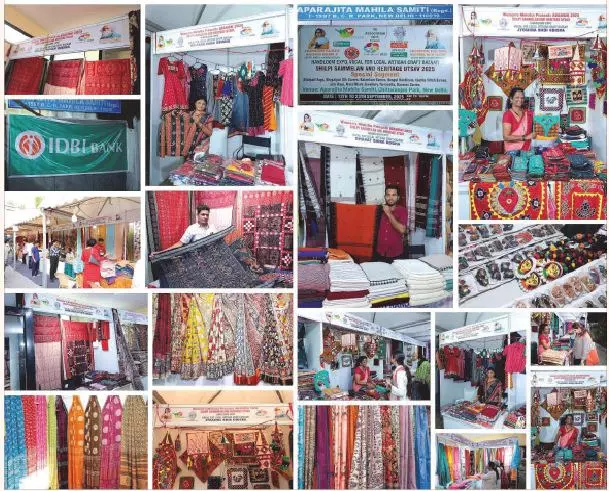
NEW DELHI, Nov. 4 -- The air inside Aparajita Mahila Samhiti carries the faint rustle of fabric and the earthy scent of clay. At every corner of the Odisha Festival, organised by Women's Moksha, hands are at work - showing off the shimmer of embroidered sarees, the bold colours of painted jute, and the earthy charm of terracotta figurines. Walking through the narrow aisles feels less like browsing a market and more like entering a living museum, where each stall is not just a shopfront but a story waiting to be told.
At one corner of the exhibition, Bhojraj Meher from Odisha adjusts the folds of a Sambalpuri Ikat sari, the fabric catching the light in subtle shifts of colour. His family has been weaving for generations - children first given small tasks, then slowly trusted with more - and he himself began at the age of eleven. "We watched our fathers and mothers at the loom," he recalls, "and they would involve us bit by bit until it became second nature."
The process he describes is painstaking: starting with plain cotton yarn, spinning it, tying it into intricate knots, dyeing it, and finally weaving the fabric into patterns that often take more than a month to complete. The most difficult stage, he admits, is also the most satisfying - knotting the threads to carry designs that reveal themselves only once the fabric is dyed and stretched out on the loom.
In earlier times, the motifs were simpler, born of limited tools. Now, with finer threads and a wider palette of colours, the sarees carry elaborate imagery - peacocks, the Konark chakra, even portraits if a customer requests. What sets his work apart, Bhojraj says with quiet pride, is the double ikat technique, rare and exacting, which requires perfect alignment of warp and weft. "Our products are unique because of that. It's not something machines can really replace."
While the skill is rooted in tradition, it hasn't remained static. Every generation adds new designs, his children are now part of the craft, and demand has grown beyond India's borders. "Business has boomed in the past decades," he says, "we even export now." Yet the essence remains the same - each sari, a month in the making, carries both the discipline of the loom and the quiet artistry of a family that has kept the craft alive for centuries.
Continuing the celebration of Odisha's vibrant crafts at the festival, Brajhrajnagar-based artisan Sangeeta Naik draws attention with her intricate Sambalpuri embroidery. Trained for six months under skilled experts, she transforms simple cotton Sambalpuri fabric into colorful household items that blend tradition with creativity. Sangeeta's creations range from keychains, lamp covers, and wind chimes to earrings, bags, purses, phone holders, and wall hangers, all showcasing meticulous patchwork. Having worked in embroidery for three years, she holds a beautifully detailed bag as her personal favorite.
At the festival, visitors admire her artistry and purchase items without bargaining, a gesture that makes her feel truly valued.
Meanwhile, Bharat Shira from Kotpat highlights Odisha's ancient weaving traditions. His craft, practiced for over 200 years, uses organic colors and natural dyes made from local tree bark, castor oil, cow dung, and fruits and seeds to transform simple yarn into exquisite dress fabrics. Unlike embroidery, the patterns emerge directly from the original weave, making each piece unique.
In this tradition, men handle the weaving while women prepare the dyes during the winter months. Each sari takes more than a month to complete, and mastering the craft requires years of dedication. The fabrics often feature Adivasi symbols inspired by dances, homes, daily life, marriages, and temples, weaving cultural heritage into every thread.
Despite the government granting a Geographical Indication (GI) tag in 2005, natural dyes are increasingly hard to find, adding to the craft's rarity.
Bharat emphasises the need to involve younger generations, ensuring that this centuries-old tradition continues to thrive and pass on Odisha's rich stories through its textiles.
The Odisha Festival is more than a showcase of skill - it is a celebration of heritage. From Bhojraj Meher's intricate ikat weaving to Sangeeta Naik's vibrant embroidery and Bharat Shira's natural-dye fabrics, each creation tells a story of tradition, dedication, and culture. By valuing these artisans, visitors help preserve centuries-old crafts and ensure that Odisha's rich artistic legacy continues to thrive for generations to come.
Published by HT Digital Content Services with permission from Millennium Post.
